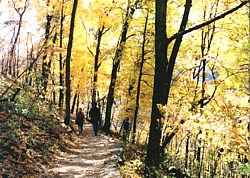
The environment of Effigy Mounds National Monument is in a constantly shifting, dynamic state. Weather, climatic change, geologic processes, fire, past agricultural practices, and pollution are only a few of the agents that affect today's environment. The agriculture of the early 1900s consisted of low intensity farming practices that eliminated some but not all of the native species that were endemic to the area. In the mid 1900s farming intensity increased with the use of tractors and row crop agriculture practices. Much of the native grasses and many of the native forbs were lost. Prairie remnants are the remains of the rarest of original habitat types. The majority of the remnants that exist today are the result of agricultural land that has been allowed to lie fallow. The combination of topography, longitude, latitude, and climate has produced unique microhabitats that support island populations of flora and fauna. Goat prairies are small prairie remnants found on bluff faces. These prairies are associated with shallow soils, south facing slopes and rock outcrops. The south aspect, shallow soils, and drier conditions select the drought tolerant native grasses over woody vegetation giving the prairie species a competitive advantage. The job of the Effigy Mounds Resource Team and Heartland Network, locating, identifying and monitoring of all special microhabitats, is important for maintaining and protecting the presettlement ecological remnants. The greatest potential for the existence of federally threatened and endangered species occurs in these areas. |
Last updated: April 10, 2015
